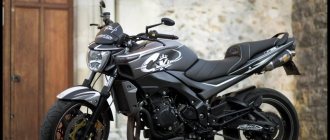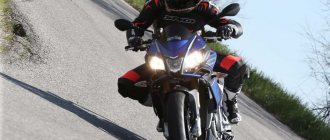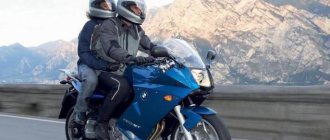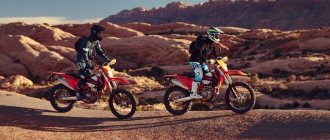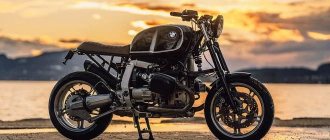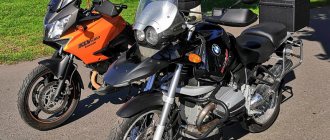| Yamaha MT-10 (FZ-10) 2016-2021 | Yamaha MT-10 SP 2017-2021 | Yamaha MT-10 Tourer Edition 2017-2020 |
| Yamaha MT-10 (2022+) | Yamaha MT-10 SP (2022+) |
Yamaha MT-10 naked bike model
was first announced at the end of 2015, and went into production in the spring of 2021. The reason for the appearance of this model was Yamaha’s desire to present to the market a flagship liter naked bike, which includes all the advanced technologies.
But why create another naked bike if there was already a Yamaha FZ-1 on the market? The fact is that the FZ-1 has practically not been updated since 2006, and therefore is quite outdated. In addition, 2015 was the last year of official sales of the FZ1 and it needed to be changed. Since the naked concept assumes the base of a sportbike, the “donor” Yamaha R1 of 2021 is radically different from that of the 2006 model, and Yamaha felt that it was time to update the top naked model and give the market not only a unique appearance, but also outstanding technical characteristics, which competitors don't. the Yamaha MT-10
was born .
In the North American market, the motorcycle was sold under the name Yamaha FZ-10
. However, by 2021 the name MT-10 was the main one in all sales markets.
The Yamaha MT-10 is based on the latest generation of the sports Yamaha YZF-R1, namely the engine, chassis, suspension and electronic systems.
The Yamaha MT-10 engine is a liquid-cooled inline 4-cylinder unit with a displacement of 998 cc. see, producing more than 160 hp. power and 111 Nm of torque. A special feature of the engine is the use of a cross-shaped crankshaft, which makes the power strokes uneven and allows for increased torque. Unlike the Yamaha YZF-R1, the MT-10 has more than 40 hp. weaker, but maximum torque became available at 9000 rpm.
The suspension and braking system are completely taken from the basic version, the only thing is that the suspension settings have been changed.
Among the electronic systems, it is worth highlighting the presence of the proprietary YCC-T system (electronic throttle), 3-level traction control, ABS, cruise control, slipper clutch, Yamaha D-Mode and QSS (quick shifter).
Thus, the Yamaha MT-10 significantly surpassed the current Japanese competitors, showing less weight and higher maximum power. Only the BMW S1000R and Aprilia Tuono V4R provide comparable performance.
In 2021, the MT-10 line will be replenished with two modifications - MT-10 SP
and
MT-10 Tourer Edition
. The main difference between the SP version and the base version is the presence of a color LCD panel and Öhlins electronic suspension (Electronic Racing Suspension (ERS)) - visually this modification is distinguished by a gold-colored fork. The Tourer Edition modification was distinguished by the presence of a touring body kit - glass, side cases, hand protection, a more comfortable saddle, a security system with GPS, and a 12V socket.
At the end of 2021, Yamaha introduced the new MT-10 and MT-10 SP for the 2022 model year. The updated versions have undergone a slight external restyling, the configuration of the front LED optics has changed, the LCD instrument panel has been replaced with a new 4.2-inch TFT color display in all versions, the engine has been updated (injection settings have changed, the intake and exhaust have been changed, maximum power increases 160 → 165.9 hp), models received a new 6-Axis IMU with new versions of the old ones + new electronic assistants.
Yamaha MT-10 / MT-10 SP: electronic equipment
- ABS
- Electronic throttle YCC-T (Yamaha Chip Controlled Throttle)
- Yamaha Chip Controlled Throttle (YCC-T) with Accelerator Position Sensor Grip (APSG) - 2022+
- D-MODE (3-mode)
- Full LED optics
- TCS (Traction Control System) (3-mode)
- Assist & Slipper clutch
- QSS (Quick Shifter System) up
- QSS (Quick Shifter System) up/down – 2022+
- Cruise control
- Electronic suspension Öhlinsn - MT-10 SP
- Yamaha Ride Control (YRC) 4-mode – 2022+
- Yamaha Variable Speed Limiter (YVSL) - 2022+
- SCS (Slide Control System) - 2022+
- Front wheel Lift Control System (LIF) – 2022+
- Engine Brake Management (EBM) - 2022+
- Brake Control (BC) System - 2022+
- 4.2′ TFT color display – 2022+
The main competitors of the Yamaha MT-10 in the class:
- Honda CB1000R
- Kawasaki Z1000
- Suzuki GSX-S1000
Bike features
Here are the main advantages of the model:
- aggressive design that embodies all the charm of current naked bikes;
- the motor is so powerful that it greatly exceeds class standards;
- Excellent handling thanks to the short wheelbase.
The Yamaha MT-10 probably has no disadvantages in principle; Another thing is that many “disadvantages” follow from the advantages. Simply put, a motorcycle is bad for some things, and completely unsuitable for others, but precisely because it is ideal in the area for which it is intended. For the MT-10, this is an urban environment. Despite the fact that its maximum speed is about 280 km/h, it will begin to deflate after 150 km/h.
Same but different
The simple fact is that the naked bike was based on the latest superbike, and not - like the Suzuki - the previous year's version is still worthy of praise. Yamaha technicians have changed many parts from the R1 engine. New features include the head and camshafts, the crankshaft is heavier, the air chamber has a 2-liter larger capacity, the valves are different sizes, and many of the parts - originally made of titanium - are made of steel in the MT-10. Thanks to these measures, the Crossplane's engine characteristics were better adapted for street use. Power is lower (158 hp), but the maximum is available much faster than in the R1, as is the torque (111 Nm), which is higher in the MT-10 than in the R1.
Brakes are old friends. They are still among the most efficient systems on the market, although the ABS system is simpler than the R-1 system.
The rear sprocket has two more teeth (43) than R1 (41). The wheels are aluminum, not magnesium.
The bottom and mid-range are stronger, which is more necessary every day, but there is no shortage in the top-end regions. What does this mean in practice? Greater engine flexibility, plenty of mid-range power, useful for daily commuting, the occasional burst of throttle, and trouble-free ride on the tires. The MT-10 engine is usually the highlight of the program. The CP4 (Crossplane 4) is an engineering marvel: it runs like a V4, sounds almost like a MotoGP machine and has brilliant performance. The only thing funny is the fact that he doesn’t “pour the collar” (he “drinks” up to 9 l/100 km with “great pleasure”).
Dimensions and weight
The tank of this motorcycle is larger than that of its predecessor and is 17 liters. This was done due to negative reviews of the previous model. Together with fuel, the weight is not that big - only 210 kg, which is not a problem for such a beast. The wheelbase is small and amounts to 1400 mm, and the seat height is 825 mm. In short, the motorcycle is not suitable for short people.
Not just a stove
The changes to the R1 aren't just about the engine. MT-10 with fuel weighs 210 kg. This is larger than the R1, although there are no fairings. There is something wrong with the logic here, but this is due to the “impoverishment” of the output package. The MT-10's wheels are aluminum not magnesium, steel tank not aluminum, non-titanium manifolds but steel, etc., etc. This makes the MT weigh more, although 210kg is still a good result . The electronics package is also inferior: the traction control and ABS in the MT-10 are simpler systems than in the R1 (no gyroscopes or IMU metering system), and the display is a regular LCD rather than a color TFT and has inferior features.
So poverty? You can argue and say so, but thanks to this, the MT costs 400,000 rubles less than the R1. The gas is still controlled by wire, and the left paddle shifters have sequential cruise control. The electronics give you a choice of three traction control modes, ABS and - like the MT-09 - three ignition maps. The cards have swapped places: in the MT-10 the strictest and most aggressive reaction to gas is card B, and in the MT-09 it is A.
Crazy on the corners, burning on the highway or terror in the city - the MT-10 will fulfill each of these tasks.
Enough technical details, time to hit the road. The Standard card is the starting point, because already the first attempts at driving in the city on the B card proved that this is not a mode for every day. In the city in B mode the bike clearly gets tired, and the throttle control - due to the rather aggressive response - is almost torture. Why bother? The STD (Standard) handles the city much better in traffic jams, providing control over the agile motorcycle. If it's raining, the softer Map A is a good choice.
Chassis and brakes
The suspensions here are quite sporty, which is reflected, among other things, in their rigidity: the travel of each of them is 120 mm. However, any adjustments are possible both at the rear and at the front, so the pendulum with a monoshock absorber and an inverted 43 mm fork will not cause any inconvenience if you use the motorcycle for its intended purpose and do not ride on broken roads, where it is appropriate to ride an enduro.
The rear uses a single 220mm brake disc along with a single-piston caliper, while up front there are a pair of robust discs that measure 320mm in diameter each. The latter are helped by four-piston calipers. Of course, it is better to buy a motorcycle with ABS installed; after all, the machine is very serious.
Sin in the city
Torturing Yamaha in the city would be a sin, so at noon I burst into the mountains. Winding roads or even asphalt will show the MT-10's true potential. Along the way, it turns out that the lens-shaped mini headlights work well, and the suspension is tuned quite universally. Vertical and straight position of the front wheel. Weight distribution between front and rear is almost perfect: 51/49%. There's enough room even for me (I'm 193 cm tall), and the more comfortable seat allows me to cover 150 km before my butt asks for a break.
In a car of this class, the savings in the form of no clutch lever adjustment are an unpleasant surprise.
Engine modes can be changed while driving. The button is located on the right half of the steering wheel.
In turn, the traction control and standard cruise control are located on the left side of the steering wheel.
To get to my destination - a turnoff in the Table Mountains in Lower Silesia - I need to dig through several kilometers of potholes in the roads. This demonstrates a certain weakness of the MT-10: the wheelbase is very small (1400 mm - less than the MT-09), and the suspension tuning makes driving over potholes and causing some nervousness. Motor spontaneity does not help here. Fortunately, this is survival, but the pleasure of the trip turns into ordinary, not the most pleasant access to the destination.
The situation changes radically on good, smooth turns. The motorcycle is comfortable, deeply thought out. It would be even more fun if the MT-10 got tires other than Bridgestone S20. They are responsible for a noticeable straightening moment and do not allow you to park the motorcycle as quickly as you would like. What else? It is worth considering strengthening the front suspension if fast cornering is in the plan. The KYB fork is fully adjustable and increasing the damping will improve front end feel.
On a multi-course course full of tight parking lots and faster, wider corners, the engine performance and setup of a well-performing gearbox is a lifesaver. The single is relatively long (up to 130 km/h), while the subsequent runs are assessed quite briefly, so combined with the engine's strong bottom and mid-range, you can pass almost every type into 2-3 combinations. The motorcycle does not require constant stirring in the gearbox, but it provides fun and a lot of adrenaline. And when exiting tighter corners, accompanied by a pleasant pulsation, the bike catapults you into the next corner, sometimes happily tearing the front wheel apart.
The MT-10 isn't as good as the R1, but that makes it cheaper than Yamaha's superbike.
The strong point (as usual with Yamaha) are the brakes. Although the ABS is simpler than the R1, it works effectively. The brakes are well proportioned and the operating point is clear, while the front end requires a little more effort. I can't complain about efficiency.
Yamaha MT-10 price based on sales advertisements
The maximum price of Yamaha MT-10 among the advertisements found is RUB 1,449,000*
The average price of Yamaha MT-10 among the advertisements found is RUB 520,000*
The minimum price of Yamaha MT-10 among the advertisements found is 1,000 rubles*
Yamaha MT-10 motorcycle in Krasnodar
11/21/2020 RUB 1,298
Yamaha MT-10SP 2021 in Novosibirsk
11/21/2020 RUB 1,478
Motorcycle Yamaha MTN1000D (MT-10SP) 2021 in Cheboksary
09.11.2020 1,478 rub.
Motorcycle Yamaha MT-10 SP in Krasnodar
02.11.2020 1,375 rub.
Motorcycle Yamaha MT-10 SP 2021 in Krasnodar
10.10.2020 1,478 rub.
Motorcycle Yamaha MT-10 SP – Shadow Gray '2020 in Moscow
10/05/2020 RUB 1,478
Yamaha MT-10 SP 2021 in Krasnodar
09/14/2020 RUB 1,449,000
Yamaha MT-10 motorcycle in Rostov-on-Don
01/25/2020 RUB 1,199,000
Yamaha MT-10 SP motorcycle in Rostov-on-Don
01/25/2020 RUB 1,366,000
Yamaha MT-10 SP motorcycle in Izhevsk
11/19/2019 RUB 1,290,000
Selling MT-1036 in Sevastopol
09/08/2019 30,000 rub.
Selling MT-1036 in Sevastopol
07/04/2019 30,000 rub.
Yamaha MT-10 SP in Shchelkovo
06.26.2019 450,000 rub.
New Yamaha MT-10 2021 in Krasnodar
06/11/2019 RUB 1,120,000
Dnepr MT-10-36 in Moscow
05/29/2019 55,000 rub.
Motorcycle MT-10 SP in Krasnodar
05/16/2019 RUB 1,366,000
Yamaha MT-10A motorcycle 2021 in Krasnodar
11/07/2016 1,000,000 rub.
Yamaha MT-10 in Volgograd
11/07/2016 1,170 rub.
* Attention! Under the maximum, average and minimum of the Yamaha MT-10 motorcycle on this page, the average cost according to advertisements for sale on the Internet is indicated, without taking into account the year of manufacture, configuration and generation of the motorcycle model.
Specifications
Technical characteristics of Yamaha MT-09:
| Model | Yamaha MT-09 / Tracer 900 |
| Motorcycle type | naked/sports tourer |
| Year of issue | 2014+ (MT-09), 2015+ (Tracer 900) |
| Frame | aluminum |
| engine's type | 3-cylinder, 4-stroke, in-line |
| Working volume | 847 cm³ |
| Bore/Stroke | 78.0 x 59.1 mm |
| Compression ratio | 11,5:1 |
| Cooling | liquid |
| Number of valves per cylinder | DOHC, 4 valves per cylinder |
| Fuel supply system | injector with YCC-T, 41 mm |
| Ignition type | TCI (digital) |
| Maximum power | 115.0 hp (84.6 kW) at 10,000 rpm TCS (Traction control system) 2-speed – MT-09 (2016+) |
| Maximum torque | 87.5 Nm (8.9 kg*m) at 8500 rpm |
| Clutch | Multi-disc in oil bath, cable drive |
| Transmission | 6-speed Quickshifter QSS – MT-09 (2017+) |
| type of drive | chain |
| Front tire size | 120/70 ZR 17M/C (58W) |
| Rear tire size | 180/55 ZR 17M/C (73W) |
| Front brakes | 2 x 298mm discs, 4-piston radial calipers (MT-09A, Tracer 900 – ABS) |
| Rear brakes | 1 disc 245 mm, 1 piston caliper (MT-09A, Tracer 900 – ABS) |
| Front suspension | 41 mm telescopic inverted fork (adjustable preload and rebound), travel – 137 mm – MT-09 (2014-2016), Tracer 900 41 mm telescopic inverted fork (fully adjustable), travel – 137 mm – MT-09 (2017+ ), Tracer 900 GT |
| Rear suspension | pendulum with monoshock absorber (adjustable preload and rebound), stroke – 130 mm – MT-09 pendulum with monoshock absorber (adjustable preload and rebound), stroke – 142 mm – Tracer 900 |
| Length | 2075 mm – MT-09 2160 mm – Tracer 900 |
| Width | 815 mm – MT-09 950 mm – Tracer 900 |
| Height | 1135 mm – MT-09 (2014-2016) 1120 mm – MT-09 (2017+) 1345/1375 mm – Tracer 900 |
| Wheelbase | 1440 mm |
| Minimum ground clearance (clearance) | 135 mm |
| Seat height | 815 mm – MT-09 (2014-2016) 820 mm – MT-09 (2017+) 845/860 mm – Tracer 900 |
| Acceleration to 100 km/h | 3.4 sec |
| Maximum speed | 224 km/h |
| Gas tank capacity | 14.0 l (including reserve - 2.8 l) - MT-09 18.0 l (including reserve - 2.6 l) - Tracer 900 |
| Motorcycle weight (curb) | 188 kg – MT-09 (2014-2016) 193 kg – MT-09 ABS (2017+) 210 kg – Tracer 900 |
Sports roots
Last year the MT-10 replaced the famous Yamaha FZ1 “phaser”, which had been on the production line for ten years. According to established tradition, the YZF-R1 sportbike became the basis for creating the flagship of the road line.
The seat is comfortable, the support helps to hold on. But the rear passenger seat is very tiny, so you need to take a companion with the appropriate landing characteristics
Let's start with the engine, rethought and redesigned. For a street hooligan - and that's exactly what the MT-10 looks like - confident traction at low and mid-range speeds is important. Therefore, the engine was derated from 200 to 160 hp, shifting the peak torque to 9000 rpm. In practice, this has led to the fact that the engine pulls perfectly already at 3000 rpm. It is so good that during the trips I finally got lazy and rode in third gear - it pulls at both 30 and 120 km/h. In general, you drive like an automatic machine.
LED optics and brake lights emphasize the technology of the Yamaha MT-10 SP
The wheelbase is the shortest in the class - only 1400 mm. The aluminum frame is slightly adapted for public roads, and the fully adjustable front suspension and rear monoshock are identical to the R1. This cocktail provided excellent maneuverability and controllability. In just a few minutes I got used to the dimensions, which was not difficult - if the steering wheel fits, then you can drive. So the MT-10 SP went through the capital's traffic jams like a knife through butter.
Filigree controllability instilled a feeling of permissiveness. The MT-10 SP acts as a tempting devil, as if saying: “Try faster - you will succeed! Don’t be afraid to accelerate sharply and make a turn, in which case I will correct your mistakes...” Indeed, there are enough “curators” in the arsenal of the MT-10 SP. A slipper clutch, which comes from sports, prevents the rear wheel from completely locking when shifting to lower gear and engine braking. ABS and traction control. The quickshifter function reminds us of our ancestor athletes - after 4000 rpm you can shift to top gear without releasing the clutch.
Brief history of the model
Model
: Yamaha MT-09;
Yamaha MT-09A (ABS) (all markets). Factory designation
: 1RC8; 2DRC.
Model
: Yamaha MT-09A (ABS);
Yamaha MT-09 Tracer (Tracer 900) (all markets). Factory designation
: 2DRM; 2SC8.
Model
: Yamaha MT-09;
Yamaha MT-09A (ABS); Yamaha MT-09 Tracer (Tracer 900) (all markets). Factory designation
: B878; 2DRT; 2SCK.
Model
: Yamaha MT-09A (ABS);
Yamaha MT-09 Tracer (Tracer 900) (all markets). Factory designation
: BS26; 2SCS.
Model
: Yamaha MT-09A (ABS);
Yamaha MT-09 Tracer (Tracer 900) (all markets). Factory designation:
BS29, B6C1 (SP); B5C1, B1J1 (GT)
Model
: Yamaha MT-09A (ABS); Yamaha MT-09 Tracer (Tracer 900) (all markets).
Model
: Yamaha MT-09A (ABS); Yamaha MT-09 Tracer (Tracer 900) (all markets).
Tuning
In Soviet times, a small abundance of equipment provoked people to individualize their motorcycle, and the Dnepr has seen many different modifications over the years.
Conversion of the Dnepr MT-10-36 into a bobber
Read other motorcycle reviews of the BMW S1000 RR: detailed review
Initially, it is worth approaching the refinement of factory jambs:
- improvements to the lubrication system;
- replacing carburetors with Japanese ones;
- installation of automobile rings and pistons;
- modification of the cylinder head and installation of automotive valves.
But often, the Dnepr is not only subject to improvement of engine components, but also serves as the basis for the construction of a completely new, custom motorcycle. In most cases, Dneprs are converted into a chopper or bobber, since a heavy motorcycle is the most suitable option for this. But there are sports and cafe racers based on the Dnieper.
Repair
Of course, there is no need to talk about any kind of service in the service. And when owning such a motorcycle, experience plays an important role, because all the pain of repairs falls on your shoulders.
Repair and maintenance Dnepr MT-10-36
Already from the moment of break-in you have to put your hands into it. During this period, the valves require adjustment every 350-500 km, then this procedure is repeated after 1-1.5 thousand km.
Despite all the proper maintenance, the cylinder-piston group has a low, by modern standards, resource, and this should be taken into account.
Also, the constant leakage of oil is not surprising; the quality of manufacture of the oil seal seats leaves much to be desired.
Burnout of the cylinder head gasket was also not uncommon. It is important during operation to keep the oil sensor in constant working order; any reason leading to oil starvation will quickly kill the engine, and the likelihood of such a reason occurring is high.
Prices for all Yamaha
| YBR125 | from 149,000 rub. |
| Fazer 250 | from 314,000 rub. |
| YZF-R3 | from 424,000 rub. |
| MT-03 | from 380,000 rub. |
| MT-07 | from 575,000 rub. |
| MT-09 | from 799,000 rub. |
| MT-09SP | from 844,000 rub. |
| MT-09 Tracer | from 745,000 rub. |
| XSR700 | will appear later |
| XSR900 | from 788,000 rub. |
| MT-10 | from 949,000 rub. |
| MT-10 SP | from 1,366,000 rub. |
| YZF-R3 | from 424,000 rub. |
| TT-R110E | from 208,000 rub. |
| WR250F | from 662,000 rub. |
| WR450F | from 715,000 rub. |
| YZ125 | from 452,000 rub. |
| YZ85LW | from 352,000 rub. |
| YZ250F | from 606,000 rub. |
| YZ450F | from 715,000 rub. |
| YZ250F | will appear later |
| YZ450F | from 519,000 rub. |
| TMAX DX | from 936,000 rub. |
| PW50 | from 120,000 rub. |
| YFM90R | from 315,000 rub. |
| FJR1300A | from 1,322,000 rub. |
| Tracer 900 | from 822,000 rub. |
| YFM700R | from 979,000 rub. |
| YFZ450R | from 779,000 rub. |
| NM-X | from 229,000 rub. |
| NMax 150 | from 209,000 rub. |
| YZF-R6 | from 1,024,000 rub. |
| YZF-R1M | from 1,799,000 rub. |
| Niken | will appear later |
| Grizzly 700 EPS | from 1,090,000 rub. |
| Kodiak 700 | from 799,000 rub. |
| Kodiak 450 | from 719,000 rub. |
| Grizzly 700 EPS | from 1,090,000 rub. |
| Grizzly 700 EPS SE | from 1,154,000 rub. |
| XV950 | from 799,000 rub. |
| SCR950 | will appear later |
| XV950 Racer | from 579,000 rub. |
| XV950R | will appear later |
| XT1200ZE Super Tenéré | from 1,160,000 rub. |
Personalize your mood
The main difference between the special version SP and the regular MT-10 is the fully adjustable Öhlins electronic suspension. You press buttons on the full-color TFT display and set the optimal parameters for the suspension, and at the same time the engine and safety systems. At the same time, the electronics still analyzes the condition of the road and adapts the specified characteristics to the realities. But artificial intelligence can be removed from creativity and parameters can be fixed. This is useful when driving on a clear route, such as a track. Moreover, the computer provides the ability to record the lap and compare the results achieved.
A distinctive feature of the special version SP is a color TFT display
The designers (or marketers?) seem to be saying: “Our bike will show itself on the track too!” Yes, racing on a sports track helps you understand both your capabilities and the potential of the bike. But still, the Yamaha MT-10 is a full-fledged streetfighter, a motorcycle with a powerful engine and modern chassis, designed for high-speed riding in urban conditions.
The basic MT-10 has three settings: for city, bad road and highway, and they are quite enough. The indicatively sporty version of the SP has more of them, if not too many. This is a reserve that cannot be fully realized. Like with crossovers with a power of 400 hp. and “maximum speed”, hypothetically exceeding 300 km/h. The potential is huge, but why? The answer is simple: so that there is!
The “basic” version of MT-10 will cost UAH 100,000. cheaper than our SP test model
Rhinestones on a smartphone do not at all affect communication capabilities, but for some they become a decisive factor in their choice. Therefore, there will probably be those who will easily shell out an additional 100,000 UAH. for the special version of this streetfighter. After all, when it comes to a motorcycle that costs half a million, that's not much.
1 of 5
Given the futuristic look of the bike, a USB connector would be quite appropriate. But there is a socket from the last century
Elements made by Öhlins are a sign of premium quality. In the basic version it costs KYB
Yamaha
“That is, you admit with a clear eye that there is a noticeable difference between even more or less identical motorcycles” Of course. I’ve already written it a hundred times - no two motorcycles are alike. A certain class of motorcycle is created for certain tasks. But they can each cope with them in their own way. But this is not a reason to think that this difference is so great that it distinguishes one motorcycle (of the same class) from another, like a car from a truck. And in the city they all differ only in how the moment shelf is configured and how, respectively. speed is felt. This is perhaps the only difference that can be felt from engine to engine. That's how it's set up. However, this does not mean that he suddenly goes faster. Just a kick gives these sensations. And everything that concerns taxiing, etc. Frames have long been made not from plasticine, and in order to understand that you have limitations on steering due to the fact that you do not have a delta box but a steel frame, you need to go to the track. And any (except for completely failed designs, of course. Manufacturers make mistakes) motorcycle will confidently fall to the anchors on the pegs. If only asphalt and tires allowed. “But the sensations, pleasure and safety of this process very much depend on the motorcycle. And here the CB1300 is not a competitor to MT at all.” What's wrong with the 1300's safety? There is ABS, there is traction, there is combibrake. The torque level is very smooth - like electric traction, and the ride is smooth, the suspension confidently swallows all the city potholes. And I'm not saying that he's incredibly cooler than everyone else. What I mean is that a global breakthrough hasn’t happened yet, and it’s still not happening, and the motorcycles in general are still the same. You just need to sell it. This is how a motorcycle will learn to fly or how everyone will finally switch to electric power. Then there will be a discussion. And so, in fact, neither the geometry of the chassis nor the engines have been particularly developed for 10-15 years. There are local achievements such as an automatic machine from a Honda or a supercharger from a Cava. But these are all special cases. In general, the only thing that is actively happening now is the massive use of light alloys to simplify and reduce the cost of production with a lighter motorcycle, but with the corresponding. consequences for durability. As Boris Razor said, “Weight is reliability.” Well, saturation with electronics occurs. Useful, but as they say, not everything. The same active electronic suspensions, on the one hand, are very cool, but on the other hand, somewhere nearby there is a report from Turinda, where in the end it felt like the classic suspension with pre-adjustments won. And this is not an isolated opinion. This means that not everything is so simple and not all yoghurts are equally healthy.
Similar models
- Suzuki GSR1000. This naked kit equipped with a 182-horsepower engine can easily compete with the Yamaha MT 10 in a number of parameters.
- Kawasaki Z1000. Another street fighter, the product of a masterly symbiosis of Kawasaki engineers and designers, who managed to create one of the most technologically advanced and stylish motorcycles of our time.
- Aprilia Tuono V4 1100RR. A very interesting Italian, incredibly powerful and also has good wind protection for a naked bike.
- BMW S1000R. A combination of Bavarian high technology, high prices and signature BMW reliability.
- Honda CB1000R. A more classic motorcycle in appearance, powerful, unusual and, at a minimum, worthy of attention.
Special equipment
Indeed, the Japanese are not lying when they say that this is a completely different motorcycle from the R1. The MT-10, while seemingly radical and super sporty, can do more. This is a truly versatile moto. It will find an answer to any conditions you put on it, regardless of whether it is on a hot track, or in the mountains, or on the highway (a wide range of travel accessories: glass, chests, etc.). It's not as radical as the KTM Super Duke 1290, but that's its advantage. High power and torque, generous equipment, a great engine and a great chassis - this is the team that is delivering maximum power right now.
Post Views: 2,657
